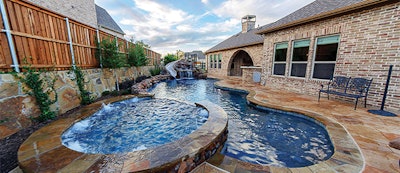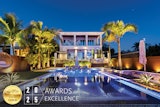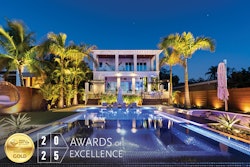
When Kathy Caviness first came upon the idea of entering the International Awards of Excellence in 2007, her husband, Kelly, was a little apprehensive.
"I knew about the contest, and I viewed it as a very prestigious award," he recalls. "I thought, 'Man, I don't even know if our pools are good enough to compete internationally.' But they were."
Today, almost 10 years later, Caviness Landscape Design, in Edmond, Okla., just outside of Oklahoma City, has more awards than the couple can keep track of, including at least one for every year they've entered.
"I have no clue why everybody doesn't enter, to be honest," he says. "It carries a lot of weight with prospective clients — especially when we explain to them that we are competing against designers and builders all over the world."
Halfway across the country, Bill Renter, CBP, of Deck and Patio Company on New York's Long Island, is as stumped as Kelly as to why more people don't bother to enter (not that he's complaining).
"I'm grateful for that," he laughs, "because there are probably a lot of guys out there that are better at what I do than I am, but they don't take the pictures, they don't enter. So they have a harder time with the sales process because they don't have the portfolio that I have, and they don't have the credentials that I have. So they are losing out on jobs."
Wall Of Fame
Like Kelly Caviness, Renter can't put a number on the plaques his company has won. If he cared to, he could count the ones that line the walls of Deck and Patio Company's design center. But even that wouldn't be a complete accounting.
"It's more than 300 — including the International Awards and regional ones," he says. "We don't have enough wall space for all of them, so we pick the ones we're most proud of, and the ones that most people like. It's a very important tool for us. It really gives our company instant credibility."
Potential clients, after an initial in-home consultation, meet a designer at the company's Huntington Station, N.Y., design center, which in addition to the wall of awards on the inside features different water features and materials on the outside.
"People usually walk past the pictures and plaques and say, 'I like this,' or, 'I want something like that,'" Renter says. "They may want something with a clean, modern look, or something more natural with streams and boulders.
"Sometimes there's a difference between what the client says and what they actually mean, and having the awards and pictures on the wall helps us bridge that gap."
Ease Of Entry
Lorna Watkins handles builder entries for APSP, and she looks forward to recruiting a new batch of entrants who'll reap those rewards this year. All that stands in the way is a few simple steps, now that APSP has streamlined the entry process.
Bill Renter is among those who appreciate the faster, more intuitive system of submitting entries for the Awards of Excellence.
"When I first started submitting for awards around 2000, you had to jump through all of these hoops in order to apply properly," he recalls. "You had to develop pictures, get them turned into slides, mail them in. But now, with technology and changes by the APSP, it is so simple."
Winners' Circle
Plaques and plaudits aren't the only benefit winners receive. In fact, according to Caviness, those may not even be the most valuable.
"I've attended the Chairman's Reception at the Expo, and have able to network with other International Awards winners," he says. "And I've become friends with a couple of them. Just being able to share things, ask questions back and forth. That's very cool. It's been a welcome surprise for me. I was shocked at how helpful it was at first."
Considering all those benefits, it's hard to justify sitting on the sidelines. "Get into the game!" Usher says. "We need more vinyl-liner entries, we need more portable spas. We want to make sure members understand they can sell more pools and hot tubs by showing customers, by winning or even just preparing for this kind of program. Even if you don't win, you've still got the pictures, and you've still got the stories behind the projects. Use those in your marketing and during sales presentations. The more you document an installation the more information you have for clients and judges."
Says Renter: "People who don't enter are foolish because it's not hard anymore. Maybe they remember how hard it was in the past. But now, filling out the application is easy. And taking a digital picture of a nice day is not hard to do, either." (See sidebar, "Picture Perfect.")
The BasicsWhat are the International Awards of Excellence? Who can enter? Categories Entry Fee More questions? Visit www.apsp.org, email Lorna Watkins at [email protected] or call (703) 838-0083, ext. 121. |
Picture PerfectThese simple steps can improve your pool photography In Eric Herman's 26 years as a writer and editor, he's thumbed through countless photographs of pool projects, from the simple to the sublime. And while he's quick to praise designers and builders for their creativity and craft, his assessment of their camera skills is less enthusiastic. "Photography is an area where the industry has come up short over the years," says Herman, currently senior editor for AQUA Magazine and former editor of WaterShapes. "The landscape architecture industry, for example, does a much better job of it than we do." That's the bad news. The good news, according to Herman, is that making better pictures is within reach, and you don't necessarily need to hire a professional to do it. "First and foremost, do not think of photography as an afterthought," he says. "Taking quality pictures of your best work is something you need to set time aside to do." Here are some hints to help you take photographs worthy of the work you've done. Be sure the site is prepared. Make sure the automatic pool cleaner isn't in the pool, remove the toys from in and around the pool, and make sure construction materials are cleaned up. "You'd be surprised at how often you see this rule broken," Herman says. "You'll have a picture of a new pool and there will be bags of cement in the shot!" Set the scene by attractively arranging the patio furniture. This is a good time to do a closer inspection for debris, including dead plant material. Be mindful of water quality. Cloudy water can ruin an otherwise great pool picture, and often obscures important parts of the pool. "If you have an interesting sub-surface feature in the pool like a tile mosaic, an interesting step configuration or a finish of some kind that you want to show up in the shot, you need clear water," Herman says. Also, be sure to vacuum the bottom of the pool. Think about what's in the frame. Is there a chain-link fence, swing set or pickup in the shot? "One of the nice things is that you can kind of edit on the fly by paying close attention to where you point the camera. You don't want to have to go back and crop things out later," Herman says. Pick the right time of day. Photographers often refer to the time right before sunrise or right after sunset at the "magic hour." The light is more diffused, you might have shadows that work to your advantage and you're going to have more interesting colors and cloud formations in the sky. Remember, though, that the hour is only one consideration. "Don't force it when it's foggy or super dark," Herman says. "The 'magic hour isn't necessarily going to be the best time to shoot your pool, but often it will be." Use the reflections in the water. Herman points to a recent cover of AQUA as an example of this. "One of the most beautiful aspects of water is how it creates a mirror, and surrounding objects or even distant views are captured in that mirror," he says. "We just ran on photo on the January cover with a vanishing-edge pool with a cloudscape that's captured both in the sky and on the surface of the pool. It's kind of like the surface of the water and the sky fuse. When you see those things, do your best to capture them. Images like that tend to win design awards." Wait for plantings to mature. If you think a pool is going to look better with more mature plantings, or when groundcover has grown in, consider holding off on photography. Take some close-ups. It's natural to want to squeeze everything into a single shot that shows the entire project. Tight shots of finer details, however, show judges (and prospective buyers) some of the finer details on the project. "To someone looking at your project through photographs, it adds a level of interest when detailed shots are interspersed with the broad shots," Herman says. Prepare your camera. Make sure you have working batteries and room on your memory card. Many digital cameras have default settings that include a landscape mode. These are good for pool photography. Above all else, pay attention to resolution. The higher the resolution, the bigger the photos can be reproduced. "I can't believe how many times I've received images of beautiful pools that I just can't use," Herman says. Use a tripod. "This takes a little extra time, but that shaky camera movement is the equivalent of shooting out of focus," Herman says. Bonus Tip: Take some vertical shots. Most entries do not include these shots, which eliminates them from consideration for magazine covers like AQUA, or even big consumer titles, which often contact APSP for photographs. |











































